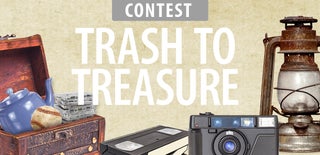Introduction: Making/Fixing Tool Grips With Plastic Bottle String
I like tools. I like to work with them. But also I like to fix and restore old or disfunctional tools, and a common issue in this case is missing, non existing or uncomfortable grips on some of them. By experimenting with my plastic bottle cutter I came up with the method of making/fixing or replacing tool grips I want to share here. On the examples on the photos you can see different variations of how you can accomplish your grips and I'll talk abot it later.
Step 1:
But first let me introduse you my bottle cutter. After a couple unsuccessful attemps to recreate designs I've seen on the interenet (I guess partially it was a fault of the bottles I was using) I eventually came up with my own design. I'm not going to clame that it is better than others (but maybe in some ways it stilll has some particular advantages (as well as disadvantages too)). This is just something I improvised with junk I had lying around in my workshop.
You can see how it works: the metal corner with a notch for a blade acts as a guide for the bottles edge; the stack of shims of different thicknesses on the end of the wooden block is how you regulate the width of the strip; two screws on the face end hold the metal corner, stack of shims and a blade all by once; the bent bar made from a nail at the side, acts as a guide for the outcoming string. Also There's a plastic bucket hanndle at the rear side to help keeping bottle at place at the start of a cutting (to be onest, it does almost nothing). Otherwise the whole construction is just a block of wood I hold in the vice.
You may feel free to recreate or improve my design. Just don't forget to send me a photos.
Step 2:
Now let's turn back to the tool grips. Here I have some old pliers I've already derusted, cleaned and rubbed with oil. For the grips you need scraps of robust 1-2mm thick leather (some old boots will do). Obviously you can use other suitable material (rubber for example) and let me know if you tried it. I've already cut pieces into size and shape.
Step 3:
Punch holes for lacing along the sides of your details. Do not try to fold your piece in half to accomplish two sides at once, it results in less accurete aligning of holes (I tried).
Step 4:
Soak leather in warm water to make it stretcy and pliable and start to lace. You may need to keep the leather wet during the process.
It makes sense to locate the lacing otside the grip to provide better durability and grip, but here I'm experimenting with different approaches (I guess the inside lacing is an opton too if you prefere more slick feal of a grip, or if the material you use provides you with secure grip just by itself). Simple lacings do the best. The fancy one I did on the pliers with grey handles on previous photos, bites into hand too much, but again, it's a matter of personal taste and a technic you applied (softer thiner plastic strip, different type of lacing, etc.)
Step 5:
And here's the finished lacings...
Step 6:
But that's not all yet. The srtip ftom PET bottles (AKA plastic bottle, AKA any soda bottle) has a cool feature: it shrinks while heated, and this gives us opportunity to improve the quality of the grips.
I recomend to use heat gun for this step (just moist the leather once again before shrinking), but if you don't have one, as I am, use the method I showing. In order to heatshrink the lacing we're gonna use boiling water. It is cool if you have a vessel where you can fully submerge the tool handles while the water is boiling. I tried to do so in my electric kettle but the pliers were too big, so i decided to use this glass pan and just pour the boiling water on top of the tool. It wasn't perfect solution but it worked.
After shrinking the lacing tightend up reliably securing the grip into place. It also helps alot with complex lacings because it is pretty hard to tie plastic strip tightly in this case.
Step 7:
Take your tool from the water and wipe it dry. Put it then to the warm place to let it dry completly as quick as possible. Reapply oil If needed.
Step 8:
And here's the result. It' looks nice, it feels nice.
I can imagine it can be done with tooled leather and leather lace. Please show the photos if you do so, I'd really like to see it. But now thank you for your attention and have a nice International Eskimo Pie Day.

Participated in the
Trash to Treasure Contest 2017

Participated in the
Epilog Contest 8











